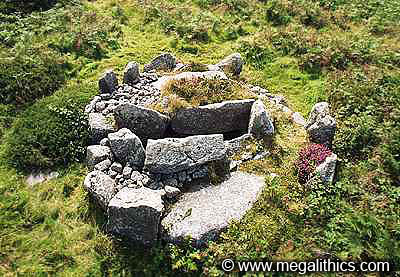
 |
Photo Gallery |
|
Panoramas |
||
| SW 43115 34228 (GPS 36min). | 4.5 x 5m approx. |
| Visited August 2001 |
The megalithic tomb at Bosiliack stands in rough moorland about 4km NW of Penzance, this lovely little monument is only 500m north of the very popular Lanyon Quoit and 1km SE of the Men-an-Tol, yet it receives very few visitors. Bosiliack is a type of monument known as an Entrance Grave, these are unusual tombs with a very restricted distribution. Entrance Graves are found only in the Scilly Isles and the very tip of Cornwall, click here for a overview of the monument class as a whole.
Described on the 1:50000 OS map as a "Tumulus", we could not find an account of the excavation of Bosiliack, or a date for its recognition as a member of the Entrance Grave class. Daniel (1) does not list Bosiliack in his 1950 inventory of Chamber Tombs, even under the category of "doubtful site", so the true nature of the tomb must have been discovered within the last 50 years.
The cairn is about 5m across NE-SW and about 4.5m along the chamber axis, although the lack of kerbs on half of the circumference makes these figures uncertain. Cairn material consists of the usual head-sized stones and is retained by the usual kerb of large stones. In contrast to the kerb stones we saw at the Brane and Pennance tombs, the majority of the Bosiliack kerbs are set with their long axis vertical, although a very large slab lying on the cairn at the NE may be a displaced kerb that was originally set lengthwise. The kerbs are virtually intact in the NE-S-SW arc, but only two definite kerbs remain on the rest of the cairn periphery, one of these exactly aligned on the chamber axis, at least three displaced kerbs stones lie close by. The mound has been robbed away to below kerb height and the chamber roof stones have been removed.
The chamber opens to the SE and consists of edge-set side slabs separated by a narrow back stone, the kerbs flanking the entrance have unusually flat inner surfaces but are not size graded, they offer a simple opening with no constriction. There is a smallish stone set immediately between the entrance kerbs, we wondered if this was a symbolic "blocking stone" used to seal the chamber. Just past the "blocking stone" was a low slab edge-set across the chamber between the first pair of side slabs, this looked very like the sill stones we have seen in many Irish megalithic tombs. The chamber is nominally straight, but the kerbs and side slabs are all set at a slight angle to each other creating a strange reverse "S" shape in plan view. The chamber is much narrower than those of other Entrance Graves we have visited, particularly between the kerbs and front side slabs. The axis of the chamber does not bisect the cairn, being offset to the NE, and as is typical of Entrance Graves, it penetrates well past the cairn centre, ending just over a metre from the outer edge of the kerb. The northeastern rear side slab is the lower of the pair and has a large stone set on its upper edge, this is probably a packing stone used to level up the side wall height. As at other Entrance Graves, the chamber was most probably roofed with flat stones, a large slab lying on the cairn at the SW being a likely candidate for a displaced roof stone.
The present state of the tomb makes it apparent that it has been excavated, but as mentioned above, we could not find an account of this. We did see Bosiliack referred to briefly in a general account of Entrance Graves as a whole, this was an unreferenced report of the find of a local late Neolithic pot at the site. Funerary pots, or urns, containing cremated bone are a common find in Entrance Grave chambers, they are also sometimes found inserted into the mound itself.
Although missing its covering cairn, we
found Bosiliack a very attractive site, its denuded state readily revealing the
typical deep penetration of the chamber into the mound. If you are planning a
visit to the Lanyon Quoit or Men-An-Tol, be sure to allow time for a visit to
this little jewel, with only 14 known examples of its kind in mainland Britain,
the rarity value alone makes it a must-see for the megalithic enthusiast.
1. Daniel G.E., The Prehistoric Chamber
Tombs of England and Wales, 1950 Cambridge University Press.